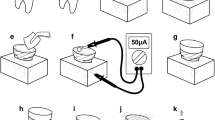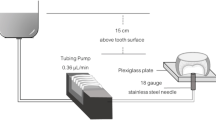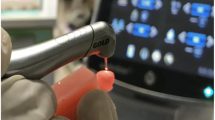Abstract
Purpose
To assess the effects of reducing the curing time of a high-power light-emitting diode (LED) unit (Valo, Ultradent, South Jordan, UT, USA) on shear bond strength (SBS) of metal brackets and on the amount of adhesive remnant of two orthodontic composites.
Methods
Eighty human premolars were divided into four groups (G1–4) according to curing time and composite: G1 (Transbond XT, 6 s), G2 (Opal Bond MV, 6 s), G3 (Transbond XT, 3 s), and G4 (Opal Bond MV, 3 s). Twenty-four hours after bonding, brackets were subject to a SBS test performed with a universal testing machine. Enamel surface was analyzed by SEM and the amount of adhesive remnant was assessed by the Image J software area calculation tool. Two-way analysis of variance was used for statistical analysis of SBS data, while Friedman and Mann–Whitney post hoc tests were used to analyze data on the amount of adhesive remnant.
Results
Time and composite significantly affected SBS (p < 0.001). The 6 s curing showed a higher SBS value (21.56 MPa) in comparison to 3 s curing (15.79 MPa). Transbond XT composite showed a significantly higher SBS value (21.06 MPa) compared to Opal Bond MV (16.29 MPa). After the SBS test, Opal Bond MV showed a significantly greater amount of composite adhered to enamel (p < 0.001).
Conclusion
Reducing exposure time from 6 to 3 s significantly decreased mean values of SBS, even with the use of a high-power LED unit. Reduction in time did not affect the amount of adhesive remnant.
Zusammenfassung
Ziel
Untersucht wurden die Auswirkungen der Verkürzung der Polymerisationszeit einer Hochleistungs-LED-Lampe („light-emitting diode“; Valo, Ultradent, South Jordan/UT, USA) auf die Scherbindungsfestigkeit (SBS) von Metallbrackets und auf die Menge der verbliebenen Adhäsivreste von 2 kieferorthopädischen Kompositen.
Methoden
Achtzig menschliche Prämolaren wurden in 4 Gruppen (G1-4) nach Aushärtezeit und Zusammensetzung eingeteilt: G1 (Transbond XT, 6s), G2 (Opal Bond MV, 6s), G3 (Transbond XT, 3 s) und G4 (Opal Bond MV, 3s). 24 h nach Bonding wurden die Brackets einem SBS-Test mittels Universalprüfmaschine unterzogen. Die Schmelzoberfläche wurde rasterelektronenmikroskopisch untersucht und die Menge der Kunststoffreste mittels des Flächenberechnungstools Image J ermittelt. Für die statistische Analyse der SBS-Daten diente die 2‑way ANOVA, die Adhäsivreste wurden mit den Post-hoc-Tests von Friedman und Mann-Whitney ausgewertet.
Ergebnisse
Sowohl Polymerisationszeit als auch Komposit nahmen signifikanten Einfluss auf die Scherbindungsfestigkeit (p < 0,001). Die Polymerisationszeit von 6s ergab einen durchschnittlich höheren SBS-Wert (21,6 MPa) im Vergleich zur kürzeren Aushärtung von 3s (15,8 MPa). Der durchschnittliche SBS-Wert von Transbond XT lag mit 21,1 MPa signifikant höher als der von Opal Bond MV (16,3 MPa). Opal Bond MV hinterließ nach dem SBS-Test eine größere Menge Komposit auf dem Schmelz (p < 0,001).
Fazit
Nach verkürzter Polymerisationszeit von 3 s fielen die durchschnittlichen SBS-Werte signifikant niedriger aus. Die verkürzte Polymerisationszeit nahm keinen Einfluss auf die Menge der verbliebenen Adhäsivreste.



Similar content being viewed by others
References
Amato PAF, Martins RP, dos Santos Cruz CA et al (2014) Time reduction of light curing: Influence on conversion degree and microhardness of orthodontic composites. Am J Orthod Dentofacial Orthop 146(1):40–46
Artun J, Bergland S (1984) Clinical trials with crystal growth conditioning as an alternative to acid etch enamel pretreatment. Am J Orthod 85(4):333–340
Bishara SE (2003) Ceramic brackets: a clinical perspective. World J Orthod 4(1):61–66
Bishara SE, Fonseca JM, Fehr DE et al (1994) Debonding forces applied to ceramic brackets simulating clinical conditions. Angle Orthod 64(4):277–282
Bland J, Altman D (1986) Statistical methods for assessing agreement between two methods of clinical measurement. Lancet 1(8476):307–310
Blankenau R, Erickson RL, Rueggeberg F (1999) New light curing options for composite restorations. Compend Contin Educ Dent 20(2):122–125
Bowen RL, Rodriguez MS (1962) Tensile strength and modulus of elasticity of tooth structure and several restorative materials. J Am Dent Assoc 64:378–387
Carvalho PEG, Santos VM, Isber H et al (2013) Halogen light versus LED for bracket bonding: shear bond strength. Dental Press J Orthod 18(1):31e1–31e6. https://doi.org/10.1590/s2176-94512013000100007
Cerekja E, Cakirer B (2011) Effect of short curing times with a high-intensity light-emitting diode or high-power halogen on shear bond strength of metal brackets before and after thermocycling. Angle Orthod 81(3):510–516
Dall’Igna CM, Marchioro EM, Spohr AM et al (2011) Effect of curing time on the bond strength of a bracket-bonding system cured with a light-emitting diode or plasma arc light. Eur J Orthod 33(1):55–59
De Munck J, Van Landuyt K, Coutinho E et al (2005) Micro-tensile bond strength of adhesives bonded to class-I cavity-bottom dentin after thermo-cycling. Dent Mater 21(11):999–1007
De Munck J, Van Landuyt K, Peumans M et al (2005) A critical review of the durability of adhesion of tooth tissue: methods and results. J Dent Res 84(2):118–132
Donatelli RE, Lee SJ (2013) How to report reliability in orthodontic research: part 1. Am J Orthod Dentofacial Orthop 144(1):156–161
Eliades T, Eliades G, Brantley WA et al (1995) Residual monomer leaching from chemically cured and visible light-cured orthodontics adhesives. Am J Orthod Dentofacial Orthop 108(3):316–321
Ferracane J, Greener E (1984) The effect of composite formulation on the degree of conversion and mechanical properties of dental restorative composites. J Biomed Mater Res 20(1):121–131
Finnema KJ, Ozcan M, Post WJ et al (2010) In-vitro orthodontic bond strength testing: a systematic review and meta-analysis. Am J Orthod Dentofacial Orthop 137(5):615–622
Jandt K, Mills R (2013) A brief history of LED photopolymerization. Dent Mater 29(6):605–617
Lamper T, Steinhäuser-Andresen S, Huth KC et al (2012) Does a reduction of polymerization time and bonding steps affect the bond strength of brackets? Clin Oral Investig 16(2):665–671
Mavropoulos A, Staudt CB, Kiliaridis S et al (2005) Light curing time reduction. Eur J Orthod 27(4):408–412
Ogaard B, Fjeld M (2010) The enamel surface and bonding in orthodontics. Semin Orthod 16(1):37–48
Retief DH (1974) Failure at the dental adhesive-etched enamel interface. J Oral Rehabil 1(13):265–284
Reynolds JR (1975) A review of direct orthodontic bonding. Br J Orthod 2(3):171–178
Richter C, Jost-Brinkmann PG (2015) Shear bond strength of different adhesives tested in accordance with DIN 13990-1/-2 and using various methods of enamel conditioning. J Orofac Orthop 76(2):175–187. https://doi.org/10.1007/s00056-014-0281-1
Rueggeberg F (2011) State-of-the-art: dental photocuring—a review. Dent Mater J 27(1):39–52
Rueggeberg F, Jordan D (1993) Effect of light-tip distance on polymerization of composite. Int J Prosthodont 6(4):364–370
Sokucu O, Siso SH, Ozturk F, Nalcaci R (2010) Shear bond strength of orthodontic brackets cured with different light sources under thermocycling. Eur J Dent 4(3):257–262
Swanson T, Dunn WJ, Childers DE et al (2004) Shear bond strength of orthodontic brackets bonded with light-emitting diode curing units at various polymerization times. Am J Orthod Dentofacial Orthop 125(3):337–341
Takaki P, Vieira M (2014) Maximum bite force analysis in different age groups. Int Arch Otorhinolaryngol 18(3):272–276. https://doi.org/10.1055/s-0034-1374647
Thind BS, Stirrups DR, Lloyd CH (2006) A comparison of tungsten-quartz-halogen, plasma arc and light-emitting diode light sources for the polymerization of an orthodontic adhesive. Eur J Orthod 28(1):78–82
Ward JD, Wolf BJ, Leite LP et al (2015) Clinical effect of reducing curing times with high-intensity LED lights. Angle Orthod 85(6):1064–1069
Yu HS, Lee KJ, Jin GC et al (2007) Comparison of the shear bond strength of brackets using the led curing light and plasma arc curing light: polymerization time. World J Orthod 8(2):129–135
Yuasa T, Iijima M, Ito S, Muguruma T, Saito T, Mizoguchi I (2010) Effects of long-term storage and thermocycling on bond strength of two self-etching primer adhesive systems. Eur J Orthod 32(3):285–290
Author information
Authors and Affiliations
Corresponding author
Ethics declarations
Conflict of interest
L.F. Almeida, R. Parsekian Martins and L. Parsekian Martins declare that they have no competing interests.
Ethical standards
All procedures performed in studies involving human participants were in accordance with the ethical standards of the institutional and/or national research committee and with the 1964 Helsinki declaration and its later amendments or comparable ethical standards.
Rights and permissions
About this article
Cite this article
Almeida, L.F., Martins, L.P. & Martins, R.P. Effects of reducing light-curing time of a high-power LED device on shear bond strength of brackets. J Orofac Orthop 79, 352–358 (2018). https://doi.org/10.1007/s00056-018-0146-0
Received:
Accepted:
Published:
Issue Date:
DOI: https://doi.org/10.1007/s00056-018-0146-0




